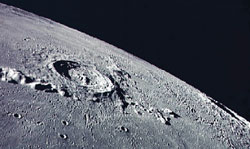 Dasain is a great time for amateur astronomers, with clear skies and free time. Most of the planets are behind the Sun now, so it's a chance to concentrate on the Craters of the Moon and some wonderful stars.
Dasain is a great time for amateur astronomers, with clear skies and free time. Most of the planets are behind the Sun now, so it's a chance to concentrate on the Craters of the Moon and some wonderful stars.
Look at the Moon in the night sky, and you can see the battered surface formed by colliding asteroids and comets some three billion years ago. The impact craters on its surface are so large, they can easily be seen with the naked eye. Lunar charts are easily downloaded from the internet, and you can use binoculars to identify some major craters like Copernicus, Kepler, Plato, and Tycho.
Along with the Craters, the lunar landscape is composed of darker and brighter areas. The brighter areas are the highlands, or Terrae, and the darker plains are called Maria, or seas. (They are not actually seas, but were wrongly identified as such by Galileo in 1610 when he was mapping the lunar surface.) With just binoculars, you can enjoy viewing Mare Crisium, Mare Imbrium, Oceanus Procellarum, Mare Serenitatis, etc. The 'chest of the rabbit' is the Mare Tranquillitatis (Sea of Tranquility) where the Appollo 11 landed in 1969.
Regarding stars, at sunset, the Great Summer Triangle (Vega-Deneb-Altair) is still overhead. Other prominent constellations to the north are the Square of Pegasus and Andromeda. Train your binoculars towards Andromeda to identify the Great Galaxy M31 (The Andromeda Galaxy).
Variable Stars change in brightness with time. October is a good time to look for Mira, a super-giant variable star in the constellation of Cetus, the Whale. This star is more than 100 times as large as our own Sun and pretty close to us too, a mere 95 light-years away. Spend some time this month trying to find Mira and seeing how its brightness changes over time.
Don't miss the occlusion of Pleiades (Seven-Sisters) by the Moon on 9 October, when the Moon will pass directly in front of the famous star cluster.  Other highlights for October:
Other highlights for October:
The Sun is in the constellation of Virgo throughout October, moving into Libra at the very end of the month.
Mercury sets about 45 minutes after the Sun on 1 October, but each evening it moves farther from the sunset until it reaches its greatest eastern elongation on the 17 October. Catch this opportunity to view Mercury with your binoculars.
Venus, which has been hard to see for some weeks now, will finally disappear behind the Sun (superior conjunction) on 27 October. We'll have to wait until late November to see the brilliant Evening Star again.
Mars is also hidden behind the Sun this month. The Red Planet is at conjunction on 23 October to become a morning object.
Jupiter may still be just visible, immediately after sunset, looking like a bright star very low in the south-western sky. We'll certainly lose sight of it by the end of the month.
Saturn in Leo, is the only naked-eye planet on view this month after midnight.
Meteors: The Draconids are a brief one-day storm lasting on 9 October! The Orionids start around the 15 October and peak on the 21st, with a rate of about 25 meteors per hour. The Taurids begin at the end of the month to peak in early November.


